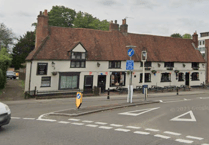More than 60 hedgelayers from around the UK and Ireland converged on East Hampshire for a Guinness World Record attempt for the longest stretch of hedge laid in 12 hours.
The event at Rotherfield Park Estate between Alton and West Meon on the A32, also raised £6,550 for prostate and breast cancer charities and the Ukraine DEC appeal.
Dr Francis Buner, senior scientist at the Game & Wildlife Conservation Trust (GWCT) was called upon for scientific advice and to act as ‘specialist witness’ for the world record bid.
And the day resulted in a remarkable 555.4 metres of hedges laid in approximately seven and a half hours – a speed of nearly 80m of hedge laying an hour.
Dr Buner said: “Whether this is a world record or not, we will find out once all the paperwork has been processed.
“Hedgelaying is a beautiful rural tradition and the people practising it are simply lovely.
“In times gone by hedgelaying was a necessity to keep livestock in fields.
“Over time each region developed its own typical style of hedgelaying.
“After being worked on, the hedge will grow back and will be brimming with wildlife once again.”
With a mix of amateurs and professionals from the National Hedgelaying Society and the National Hedgelaying Society of Ireland all working in 10m strips, the attempt involved more than 60 hedgelayers.
The local east Hampshire team was joined by teams from north Somerset, Lancashire and Westmoreland, Devon, the south of England, Midlands, Cheshire and Ireland.
Many of the teams brought their own regional styles of hedgelaying, including the Midlands style and the Irish freestyle.
Conditions on the day meant the record attempt was difficult to compare to a previous hedgelaying record achieved, of just over 280m of hedge laid in 12 hours by two people.
Hedges should ideally be laid at eight or nine years old.
But at Rotherfield, they had last been coppiced (cut down to 1ft tall) around 18 years ago and were already 30 to 40 years old at that point.
Combined with the exceptionally dry spring and summer, this meant the stems and trunks were extremely thick and brittle.
The hedges also included a mix of species with plenty of thorn bushes, proving a challenge for even the most seasoned of hedgelayers.
As well as being useful to farmers, GWCT wildlife monitoring has shown that proper management of hedgerows, including hedgelaying, is highly beneficial to wildlife.
Dr Bruner added: “I have been doing bird surveys in the area where these hedges were laid since 2010.
“In that time farmland birds of conservation concern, such as skylark, linnet, yellowhammer, dunnock and song thrush have increased by more than 90 per cent
“That is testament to the efforts of Rotherfield team to improve habitat on their farm.
“During the same period, these birds have continued to decline nationally.
“The GWCT is proud to have been involved with the recovery of wildlife at the Rotherfield Park Estate.”
For more information on the Hedgelaying Society and how they are working to maintain the traditional skills of hedgelaying and encourage the management of hedgerows for the benefit of wildlife and landscape, visit the website at www.hedgelaying.org.uk





Comments
This article has no comments yet. Be the first to leave a comment.